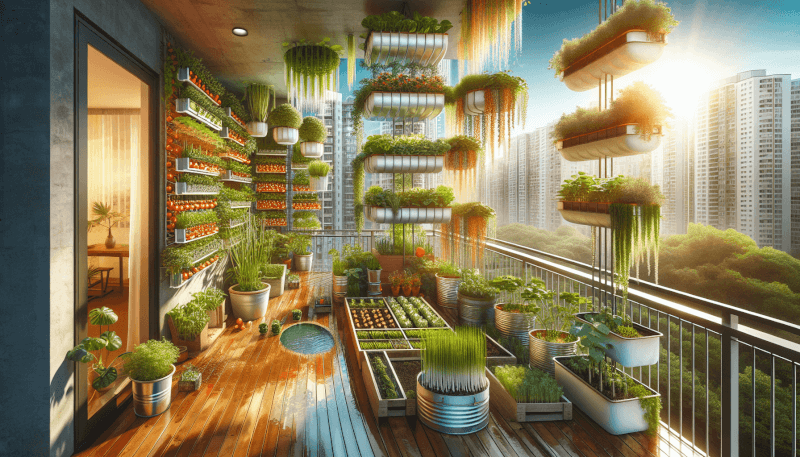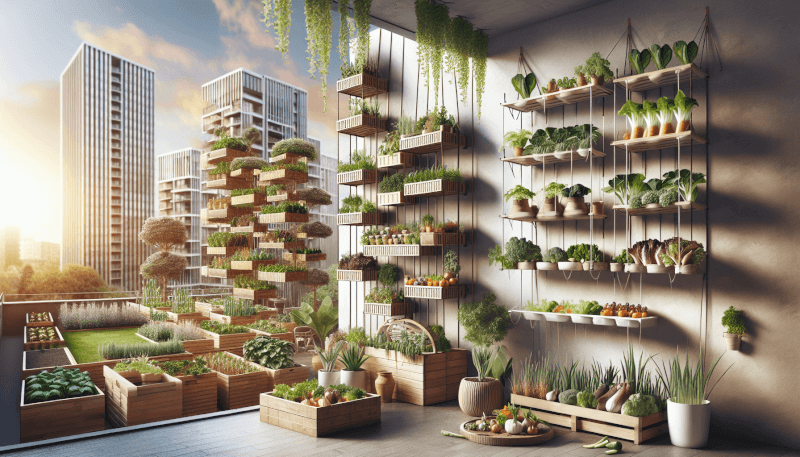If you’re a city dweller with a green thumb, but limited outdoor space, fret not! This article is your guide to transforming your apartment patio into a thriving vegetable garden oasis. With a plethora of creative ideas and practical tips, you’ll be able to grow your own fresh produce and add a touch of nature to your urban haven. From vertical gardens to container gardening, this article has everything you need to create a bountiful and beautiful space to satisfy your gardening desires. So, let’s get started on turning your apartment patio into a flourishing vegetable garden paradise!

Container Selection
Choosing the Right Containers
When it comes to container gardening, choosing the right containers can significantly impact the success of your vegetable garden. Look for containers that are the appropriate size for the vegetables you intend to grow. Consider factors such as depth, width, and ventilation. Additionally, opt for containers made of durable materials that can withstand outdoor elements.
Consideration for Drainage
Proper drainage is crucial for the health of your vegetables. Ensure that your containers have drainage holes at the bottom to prevent water from accumulating and causing root rot. If you have chosen containers without drainage holes, consider drilling some yourself or layering the bottom with gravel to improve drainage.
Sourcing Containers
Container gardening offers a wide range of options when it comes to container selection. Instead of purchasing new containers, you can repurpose items like buckets, baskets, or even old furniture with proper modifications. Visit local second-hand stores or online marketplaces to find unique and affordable containers for your apartment patio vegetable garden.
Selecting Vegetables
Determining Suitability for Containers
Not all vegetables thrive in containers, so it’s essential to choose varieties that are well-suited for this type of gardening. Vegetables like tomatoes, peppers, lettuce, herbs, and radishes are excellent choices for container gardening. Avoid vegetables that require extensive root systems or grow in large bushes, as they may not do well in confined spaces.
Space and Yield Considerations
Consider the available space on your apartment patio when selecting vegetables for your container garden. Compact varieties and bushy plants take up less space and are ideal for small gardens. Additionally, keep in mind the yield you desire. If you have limited space, opt for vegetables that produce a high yield in a smaller footprint, such as cherry tomatoes or zucchini.
Variety Selection
Variety selection plays a crucial role in the success of your container garden. Look for varieties labeled as “dwarf,” “patio,” or “container” to ensure they are suitable for a confined environment. Additionally, choose vegetables that have shorter maturation times, allowing you to enjoy the fruits of your labor sooner.
Soil and Nutrients
Quality Potting Mix
Choosing a high-quality potting mix is essential to provide the necessary nutrients and moisture retention for your vegetables. Avoid using garden soil, as it may become compacted and hinder proper drainage. Look for potting mixes specifically formulated for containers, which often contain a blend of organic matter, perlite, and vermiculite to ensure proper aeration and moisture balance.
Adding Organic Matter
To enrich the soil and improve nutrient availability, consider adding organic matter to your potting mix. Compost, well-rotted manure, or worm castings are excellent options for providing essential nutrients and beneficial microbes. Mix these organic amendments into the potting mix before planting your vegetables to promote healthy root growth and overall plant vigor.
Fertilizing Container Plants
Container plants rely on regular fertilizer applications to replenish nutrients that are washed away with watering. Use a balanced, slow-release fertilizer or organic fertilizers specifically formulated for container plants. Follow the recommended application rates on the fertilizer packaging, ensuring you do not overfertilize, as this can lead to nutrient imbalances and plant damage.

Sunlight Requirements
Understanding Sun Exposure
Before placing your containers, it’s crucial to understand the sun exposure your apartment patio receives. Some vegetables require full sun, meaning they need at least six hours of direct sunlight per day. Others can tolerate partial shade, thriving with around four hours of direct sunlight. Observe your patio throughout the day to determine where the sun shines the longest and position your containers accordingly.
Utilizing Shading Techniques
If your apartment patio receives intense sunlight for extended periods, you may need to provide some shade to prevent your vegetables from wilting or getting sunburned. Use umbrellas, shade cloth, or tall plants strategically placed to create shade during the hottest parts of the day. Remember to adjust the shading techniques as the sun’s position changes throughout the day and the seasons.
Positioning Containers for Optimal Sunlight
To maximize sun exposure, position your containers strategically. Place them in areas that receive the longest duration of sunlight. If your patio has limited sun exposure, consider using wheeled containers that allow you to move the plants throughout the day, following the sun’s path and providing adequate sunlight to each vegetable.
Watering and Irrigation
Establishing Watering Routine
Consistent watering is vital to the health of your container vegetables. Establish a watering routine based on the specific needs of your plants and the prevailing weather conditions. Check the moisture level in the containers regularly by inserting your finger an inch into the soil. If it feels dry, it’s time to water. Avoid overwatering, as this can lead to root rot, while underwatering can cause the plants to wilt and weaken.
Proper Drainage Management
Ensure that your containers have proper drainage to prevent waterlogging. Elevate the containers slightly using pot feet or similar objects to allow excess water to flow freely. Place saucers or trays under the containers to collect any runoff, but be sure to empty them shortly after watering to avoid root rot. Monitor the drainage regularly to ensure there are no blockages that could impede water flow.
Irrigation Options for Apartment Patios
If you have a busy schedule or are concerned about forgetting to water your vegetable garden, consider investing in automated irrigation systems or self-watering containers. Drip irrigation systems, soaker hoses, or even simple irrigation spikes can provide a consistent water supply to your plants, reducing the need for manual watering. Self-watering containers have a reservoir that gradually releases water to the plants, ensuring they receive adequate moisture without constant intervention.
Vertical Gardening
Utilizing Trellises and Stakes
Vertical gardening is an excellent technique for maximizing space and growing vining vegetables. Install trellises or stakes in your containers to support plants like cucumbers, peas, or beans. These structures provide stability for the plants and encourage vertical growth, reducing the footprint required for their cultivation. Choose trellises and stakes that are sturdy and tall enough to accommodate the expected growth of your vegetables.
Growing Vining Vegetables
Vining vegetables are well-suited for vertical gardening in containers. They include plants like tomatoes, cucumbers, pole beans, and melons. Train the vines to climb the trellises or stakes, guiding them as they grow. Regularly prune the excess foliage to maintain a compact and manageable size. Provide additional support for heavy fruits by using slings or mesh bags tied to the trellis.
Maximizing Space with Vertical Planters
If you have limited patio space, consider using vertical planters to grow your vegetables. These planters have multiple tiers or pockets, allowing you to stack plants vertically. Herbs, lettuce, and strawberries are particularly well-suited for vertical planters. Be sure to choose planters made of sturdy materials that can hold the weight of the soil and plants when stacked.
Companion Planting
Beneficial Plant Combinations
Companion planting involves growing different plants together to benefit one another. Certain combinations can help deter pests, improve nutrient uptake, and enhance the overall health of your vegetable garden. For example, planting marigolds alongside tomatoes can repel aphids, while basil can attract beneficial insects that prey on pests. Research suitable companion plants for your chosen vegetables to optimize their growth and resilience.
Natural Pest Control
Companion planting can also serve as a natural method of pest control. Some plants emit strong scents or natural compounds that repel or confuse pests. For example, planting onions or garlic near your leafy greens can deter pests like aphids or beetles. Additionally, attracting beneficial insects through companion planting can help control pest populations without relying on chemical pesticides.
Enhancing Pollination
Certain vegetables require pollination to produce fruits. By incorporating companion plants that attract pollinators, such as bees or butterflies, you can enhance the pollination process and increase your vegetable yield. Flowers like zinnias, cosmos, or sunflowers are attractive to pollinators and can be planted alongside your vegetable containers to encourage their visitation.
Container Maintenance
Regular Watering and Fertilizing
Regular maintenance is essential for the health and productivity of your container vegetables. Stick to your established watering routine, adjusting as needed based on weather conditions. Remember to fertilize your plants at regular intervals according to the directions of your chosen fertilizers. Check the soil moisture, nutrient levels, and overall appearance of your plants regularly to address any issues promptly.
Pruning and Harvesting
Pruning your container vegetables can help maintain their size, shape, and overall health. Remove any dead or diseased foliage to prevent the spread of diseases. Additionally, pinch back the tips of vining plants to encourage branching and bushier growth. Harvest your vegetables when they are ripe, promoting continuous production and preventing overcrowding in the containers.
Preventing Disease and Pests
To prevent the occurrence of diseases and pests, practice good hygiene in your container garden. Remove any fallen leaves or debris that can serve as breeding grounds for pests or harborage for diseases. Regularly inspect your plants for signs of pest infestations or disease symptoms. Address these issues promptly, utilizing organic methods like insecticidal soaps, neem oil, or horticultural oils.
Creative Display Ideas
Arranging Containers for Aesthetic Appeal
Container gardening offers a chance to create visually appealing displays on your apartment patio. Consider the colors, heights, and textures of your vegetable plants and arrange them in a visually pleasing manner. Group containers of varying sizes to create interest, or create a focal point with a larger, centrally placed container. Combine vegetables with colorful flowers or ornamental grasses to add a touch of beauty to your edible garden.
Utilizing Hanging Baskets and Wall Pockets
Maximize space and create a striking display by incorporating hanging baskets and wall pockets into your container garden. Hang baskets from walls, railings, or hooks and plant trailing vegetables like tomatoes, peppers, or strawberries. Wall pockets can be attached to the side of your apartment building or hung from fences, allowing you to grow a variety of herbs or small vegetables.
Adding Decorative Elements
Incorporate decorative elements to further enhance the aesthetic appeal of your apartment patio vegetable garden. Use plant markers or colorful tags to label your vegetable plants. Add decorative stones, statues, or colorful containers to create focal points or add a touch of whimsy. Let your creativity shine, and enjoy not only the taste of your homegrown vegetables but also the visual delight they bring.
Tips for Small Spaces
Balcony Gardening
If you have a small balcony, you can still have a thriving vegetable garden. Utilize railing planters, hanging baskets, or vertical planters to maximize space. Choose compact varieties of vegetables and focus on crops that grow well in containers. Utilize the vertical space by attaching trellises to your balcony walls or railing, allowing vining vegetables to climb and create a beautiful green screen.
Window Sill Gardens
Window sill gardens are perfect for those with limited outdoor space. Select vegetables that thrive in partial shade and place them in small containers on your windowsills. Herbs like basil, parsley, or chives are excellent choices for windowsill gardens, providing fresh flavors to your culinary creations. Just ensure that your windowsill receives enough sunlight to support the growth of your chosen vegetables.
Utilizing Vertical Space
When space is limited, utilizing vertical space is key. Install vertical shelving units, wall-mounted planters, or tiered containers to grow your vegetables vertically. This allows you to grow more plants in a smaller footprint. Consider the weight-bearing capacity of your chosen structures and ensure they are securely mounted to prevent accidents. With proper planning and creativity, you can turn even the smallest spaces into productive and beautiful vegetable gardens.
In conclusion, with the right container selection, suitable vegetable choices, proper soil and nutrient management, optimal sunlight exposure, efficient watering and irrigation techniques, smart use of vertical gardening, companion planting for pest control and pollination, regular maintenance, creative display ideas, and useful tips for small spaces, you can create a flourishing apartment patio vegetable garden. Embrace the joy of growing your own food, even in limited spaces, and enjoy the bountiful harvests and aesthetic appeal of your thriving garden. Happy gardening!

